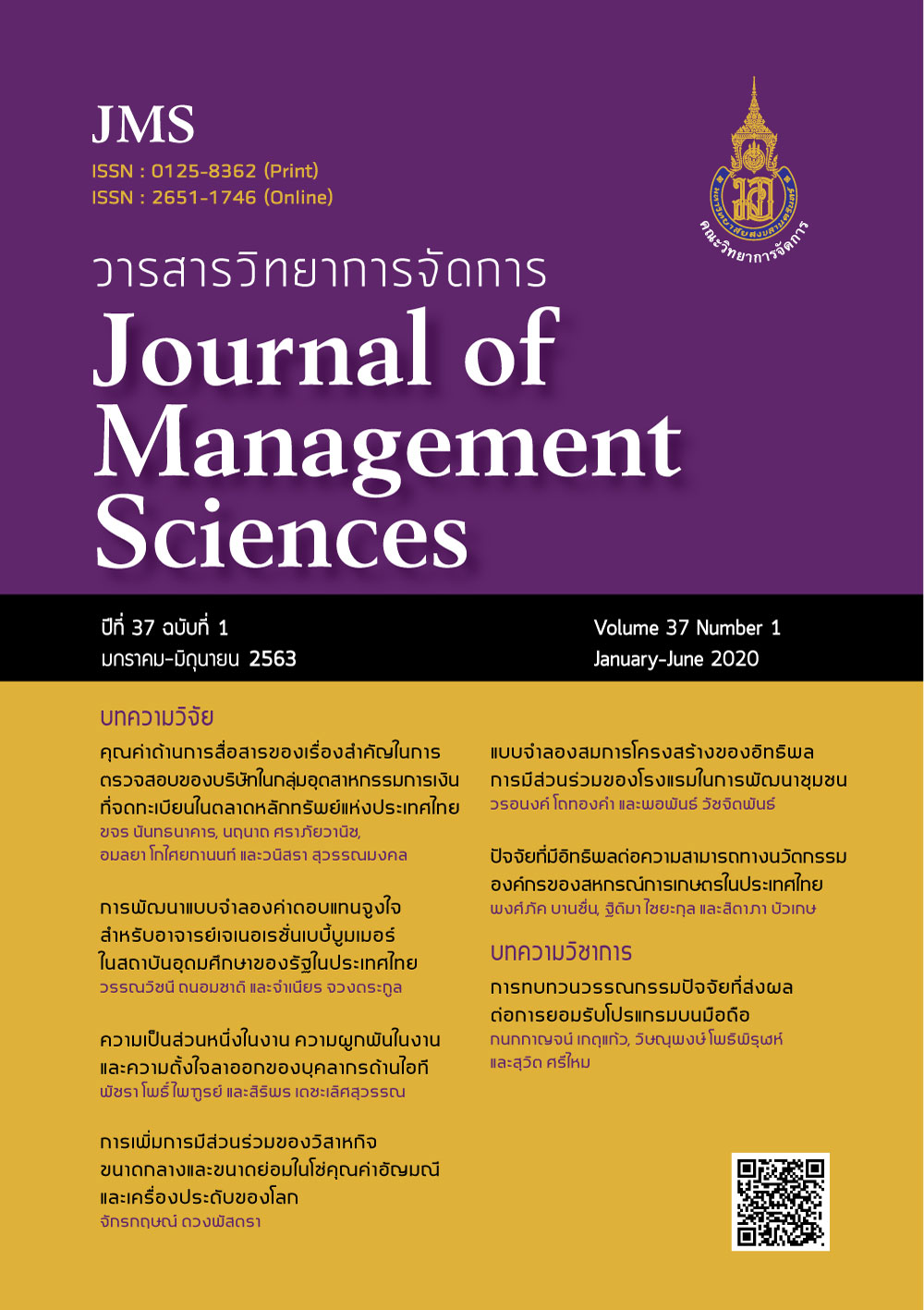การทบทวนวรรณกรรมปัจจัยที่ส่งผลต่อการยอมรับโปรแกรมบนมือถือ
Main Article Content
บทคัดย่อ
ธุรกิจการพัฒนาโปรแกรมบนมือถือได้เติบโตอย่างรวดเร็ว แต่มีธุรกิจเพียงจำนวนน้อยที่ประสบความสำเร็จ ส่วนหนึ่งเป็นเพราะไม่ได้รับการยอมรับจากผู้ใช้งาน บทความนี้มีวัตถุประสงค์เพื่อศึกษาปัจจัยที่ทำให้โปรแกรมบนมือถือเป็นที่ยอมรับ โดยใช้แนวคิดจาก 3 ทฤษฎี ได้แก่ ทฤษฎีการยอมรับการใช้เทคโนโลยีสารสนเทศ ทฤษฎีรวมการยอมรับและการใช้เทคโนโลยี และทฤษฎีการแพร่กระจายของนวัตกรรม ทั้งนี้ ไม่มีทฤษฎีใดเพียงทฤษฎีเดียวที่สามารถอธิบายการยอมรับโปรแกรมบนมือถือได้อย่างสมบูรณ์ และปัจจุบันยังขาดการสังเคราะห์ทฤษฎีในเชิงลึก ผู้เขียนจึงได้คัดเลือกบทความวิชาการและบทความวิจัยที่จัดอยู่ใน SCImago Journal & Country Rank จำนวน 25 ฉบับใน Quartiles 1, 2 และ 3 จำนวน 22, 1 และ 2 ฉบับ ตามลำดับ ด้านธุรกิจ การจัดการ การตลาด การบัญชี และเทคโนโลยีสารสนเทศ โดยผู้เขียนได้วิเคราะห์สรุปปัจจัยที่ส่งผลต่อการยอมรับโปรแกรมบนมือถือจากทั้ง 3 ทฤษฎี ผลการศึกษาพบว่า จะต้องพิจารณาปัจจัยทั้ง 12 ประการ ในกระบวนการ 5 ขั้นตอน ได้แก่ (1) ปัจจัยภายนอก (2) การรับรู้ประโยชน์ (3) การรับรู้ความง่าย (4) อิทธิพลจากสังคม (5) ความเข้ากันได้กับสิ่งที่มีอยู่เดิม (6) สภาพสิ่งอำนวยความสะดวกในการใช้ (7) ความคุ้มค่าด้านราคา (8) การได้ทดลองใช้ก่อน (9) การสังเกตเห็นผลได้ (10) นิสัย (11) แรงกระตุ้นด้านความบันเทิง และ (12) ทัศนคติ การศึกษานี้สามารถเติมเต็มช่องว่างการวิจัยซึ่งอธิบายได้ว่าปัจจัยใดที่ส่งผลต่อการยอมรับในขั้นตอนใดของกระบวนการยอมรับบ้าง ทำให้นักการตลาดและนักพัฒนาโปรแกรมสามารถนำไปเป็นแนวทางสร้างให้ผู้ใช้เกิดการยอมรับสูงขึ้น
Article Details

อนุญาตภายใต้เงื่อนไข Creative Commons Attribution-NonCommercial-NoDerivatives 4.0 International License.
บทความที่ตีพิมพ์ถือเป็นลิขสิทธิ์ของวารสารวิทยาการจัดการ มหาวิทยาลัยสงขลานครินทร์ อย่างไรก็ตาม กองบรรณาธิการไม่สงวนลิขสิทธิ์ในการทำซ้ำ คัดลอก หรือเผยแพร่ แต่จะต้องอ้างอิงให้ถูกต้องตามหลักวิชาการ
เอกสารอ้างอิง
Al-Jabri, I. M., & Sohail, M. S. (2012). Mobile banking adoption: Application of diffusion of innovation theory. Journal of Electronic Commerce Research, 13(4), 379-391.
Chan-Olmsted, S., Rim, H., & Zerba, A. (2013). Mobile news adoption among young adults: examining the roles of perceptions, news consumption, and media usage. Journalism & Mass Communication Quarterly, 90(1), 126-147.
Chong, A. Y. L., Chan, F. T., & Ooi, K. B. (2012). Predicting consumer decisions to adopt mobile commerce: Cross country empirical examination between China and Malaysia. Decision Support Systems, 53(1), 34-43.
Davis, F., Bagozzi, R. P., & Warshaw, P. R. (1989). User acceptance of computer technology: A comparison of two theoretical models. Management Science, 35(8), 982–1003.
Dillon, A., & Morris, M. G. (1996). User acceptance of new information technology: Theories and models Annual Review of Information Science and Technology, 14(4), 3-32.
Distimo. (2011). Apple App Store makes 6x more revenue than Android market. Retrieved March 13, 2019, from https://www.gsmarena.com/apple_app_store_generates_6_times_more_revenue_than_android_market-news-3558.php
Dogtiev, A. (2019). App download and usage statistics (2018). Retrieved March 12, 2019, from http://www.businessofapps.com/data/app-statistics/
Google. (2016). How people use their phones for finance activities. Retrieved April 7, 2018, from https://www.thinkwithgoogle.com/advertising-channels/apps/app-marketing-mobile-banking/
Google/Ipsos. (2016). How people shop on their phones. Retrieved April 7, 2018, from https://www.thinkwithgoogle.com/advertising-channels/apps/app-marketing-mobile-shopping/
Hsiao, C. H., Chang, J. J., & Tang, K. Y. (2016). Exploring the influential factors in continuance usage of mobile social Apps: Satisfaction, habit, and customer value perspectives. Telematics and Informatics, 33(2), 342-355.
Huang, A. H., Chen, K., Yen, D. C., & Tran, T. P. (2015). A study of factors that contribute to online review helpfulness. Computers in Human Behavior, 48, 17-27.
Hyrynsalmi, S., Seppänen, M., Aarikka-Stenroos, L., Suominen, A., Järveläinen, J., & Harkke, a. V. (2015). Busting myths of electronic word of mouth: The relationship between customer ratings and the sales of mobile applications. Journal of Theoretical and Applied Electronic Commerce Research, 10(2), 1-18.
Joo, Y. J., Lim, K. Y., & Lim, E. (2014). Investigating the structural relationship among perceived innovation attributes, intention to use and actual use of mobile learning in an online university in South Korea. Australasian Journal of Educational Technology, 30(4), 427-439.
Kang, J. Y. M., Mun, J. M., & Johnson, K. K. (2015). In-store mobile usage: Downloading and usage intention toward mobile location-based retail apps. Computers in Human Behavior, 46, 210-217.
Kiwanuka, A. (2015). Acceptance process: The missing link between UTAUT and diffusion of innovation theory. American Journal of Information Systems, 3(2), 40-44.
Lin, A., & Chen, N. C. (2012). Cloud computing as an innovation: Percepetion, attitude, and adoption. International Journal of Information Management, 32(6), 533-540.
Liu, F., Zhao, S., & Li, Y. (2017). How many, how often, and how new? A multivariate profiling of mobile app users. Journal of Retailing and Consumer Services, 38, 71-80.
Localytics. (2016). The 2016 app marketing guide. Retrieved March 12, 2019, from http://pages.localytics.com/2016-app-marketing-guide.html
López-Nicolás, C., Molina-Castillo, F. J., & Bouwman, H. (2008). An assessment of advanced mobile services acceptance: Contributions from TAM and diffusion theory models. Information & Management, 45(6), 359-364.
Min, S., So, K. K. F., & Jeong, M. (2019). Consumer adoption of the Uber mobile application: Insights from diffusion of innovation theory and technology acceptance Model. Journal of Travel & Tourism Marketing, 36(7), 770-783.
Moore, G. C., & Benbasat, I. (1991). Development of an instrument to measure the perceptions of adopting an information technology innovation. Information Systems Research, 2(3), 192-222.
Muk, A., & Chung, C. (2015). Applying the technology acceptance model in a two-country study of SMS advertising. Journal of Business Research, 68(1), 1-6.
Ozturk, A. B., & Hancer, M. (2015). The effects of demographics and past experience on RFID technology acceptance in the hospitality industry. International Journal of Hospitality & Tourism Administration, 16(3), 275-289.
Pagani, M. (2004). Determinants of adoption of third generation mobile multimedia services. Journal of Interactive Marketing, 18(3), 46-59.
Park, S. Y. (2009). An analysis of the technology acceptance model in understanding university students' behavioral intention to use e-learning. Educational Technology & Society, 12(3), 150-162.
Positioning (2017). Thai people has average 32 apps on smartphone, but buy the item in apps more than others country in region. Retrieved April 7, 2018, from https://positioningmag.com/1109998
Rogers, E. (2003). The diffusion of innovations (5th ed.). New York: The Free Press.
Rogers, E. M. (1983). Diffusion of innovations (3rd ed.). London: The free press.
Smartbear. (2014). Nearly 50% of consumers will delete a mobile app if they encounter a single bug, reveals survey by smartBear. Retrieved March 12, 2019, from https://smartbear.com/news/news-releases/the-state-of-mobile-testing-2014.aspx/
Venkatesh, V., & Davis, F. D. (2000). A theoretical extension of the technology acceptance model: Four longitudinal field studies. Management Science, 46(2), 186-198.
Venkatesh, V., Thong, J. Y. L., & Xu, X. (2012). Consumer acceptance and use of information technology: Extending the unified theory of acceptance and use of technology. MIS Quarterly, 36(1), 157-178.
Yi, M. Y., Jackson, J. D., Park, J. S., & Probst, J. C. (2006). Understanding information technology acceptance by individual professionals: Toward an integrative view. Information & Management, 43(3), 350-363.

